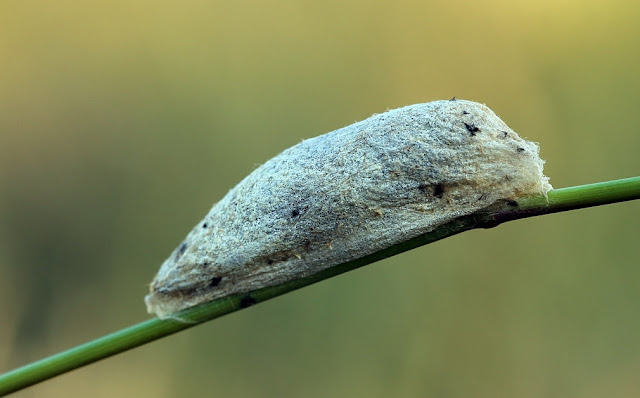I'm not sure the 13th is a great day to be starting a blog update, but, hey-ho! However, this year is flying by already and so I should crack on with it. It's true you know, as we age time passes (or appears to) more swiftly. I'm not personally sure about Einstein's theory though: 'As we get older each year is a smaller part of our life. When I was 10 each year was 1 tenth of my life. I’m now 60 each year 1/60th of my life.'
One eminent professor hypothesizes that, over time, the rate at which we process visual information slows down, and this is what makes time ‘speed up’ as we grow older.
And so, just in case that is true, I'd better stop waffling and share some worthwhile content. Let's begin with these beautiful little Skipper butterflies that I photographed in the fields behind the house...
It's hard for me to be certain from these images, but I think that based on the general colouring, wing markings, and antennae detail, these are probably all Small Skippers (Thymelicus sylvestris).
--------------------------------------------
I always say that there is something new to learn each and every year, and even at my advanced age of...well never mind how old I am! But, even at my age, I am still learning new things. This next find is a case in point; when I spotted these tiny eggs on some foliage in the same field as the Skippers, I thought at first sight they might be Ladybird eggs. But they seemed on closer inspection to be slightly too large, and too, well, egg-like. Ladybird eggs have a more pointed appearance.
What could they be then? Well, the foodplant was a big clue: ragwort. A quick 'Google' revealed that these are the eggs of the moth we most associate with ragwort: the Cinnabar. Here's a picture of the caterpillars emerging. At this stage they really are small; about 3-4mm long...

Here's how the fully grown caterpillars will look...
and this is the stunning, adult moth...
This one area had one more surprise to offer; I spotted what I thought was a Burnet moth cocoon. They look like this...
But here is my find...
It looked a bit too large, and slightly too rough-hewn of construction to be Burnet moth. This turned out to be my second education of the week, because having observed it closely, the very next morning, just look what emerged...
A closer look...
What a fabulous, and quite large moth, this is. This one is the Drinker moth (Euthrix potatoria) and I was so pleased to have the chance to catch it looking so fresh and pristine. The pale colour of this individual tells me that it's a female.This is a screenshot of the Drinker caterpillar, from an earlier post of mine...
This species gets its English (and Latin) name from the habits of the caterpillar, which is supposed to have a liking for drops of dew. Here's the thing though: and this is where age plays a part again, because I was convinced at first that although I often find the big caterpillars, I had not seen an adult moth before. Wrong!
It must have been a day later when I was sitting having my morning sip from the caffeine-cup, when it crossed my mind that I might have actually photographed one before? A check through my Flickr photo-stream revealed this image...
As you can see it was taken in 2017 and is a much darker male moth.
Each year seems to see a decrease in the amount and variety of bugs that I get to find and record. It's been a few years now since I have seen and photographed a Tortoise beetle; they look like this...
I have seen a couple this year however, but no photos as yet. What I did photograph though was a larva of the species. These are most unlike the adult beetles in appearance and have a rather curious habit: the posterior possesses two-pronged appendages. These are used to carry a roof of old faecal matter and plant debris, shielding the insect using camouflage....

A pristine example looks like this...
Oh! I forgot to say that had that cocoon been a Burnet moth, this is what would have emerged...
A couple of oddities to end on then. What do you think this next image might be? And it isn't an owl on a bonfire! That's the only clue you are going to get. But you probably know anyway, right?
Yes, it is a Ladybird (or bug if you are in the USA) pupa. In particular, a Harlequin (or Asian if you are in the USA) Ladybird pupa.
And finally, this...
The Vampire fly! Well, not exactly; it's a Horsefly. But these females have mouthparts that are able to break the skin, to allow them to feed on warm blood! It is even possible for them to bite through clothing. Yes people...females can be dangerous; you have been warned.
Males however are much sweeter. Yes, I am talking about male Horseflies by the way (smiley face) because they feed on nectar.
It does seem though that the flies home in on their next victim by sniffing out exhaled carbon dioxide. This means that those doing more strenuous outdoor activities could be at greater risk of being bitten. Phew! That excludes me then.






















No comments:
Post a Comment